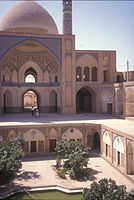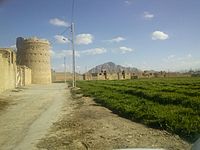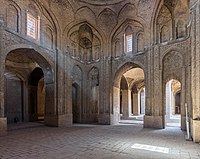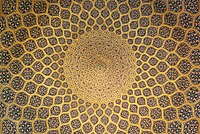Isfahan Province (Persian: استان اصفهان, romanized: Ostān-e Esfahān), also transliterated as Esfahan, Espahan, Isfahan, or Isphahan, is one of the 31 provinces of Iran. The city of Isfahan is the provincial capital. It is located in the center of the country in Iran's Region 2,[4] whose secretariat is located in Isfahan.
Isfahan Province استان اصفهان | |
|---|---|
 Location of Isfahan province within Iran | |
| Coordinates: 32°39′28″N 51°40′09″E / 32.6577°N 51.6692°E | |
| Country | Iran |
| Region | Region 2 |
| Capital | Isfahan |
| Counties | 29 |
| Government | |
| • Governor-general | Reza Mortazavi |
| • MPs of Assembly of Experts | 1 Abdol Mohammad Abdolahi 2 Morteza Moghtadai 3 Seyed Abolhasan Mahdavi 4 Yousef Tabatabai Nejad |
| • Representative of the Supreme Leader | Yousef Tabatabai Nejad and Saeed Hosseini (Kashan) |
| Area | |
| • Total | 107,018 km2 (41,320 sq mi) |
| Population (2016)[2] | |
| • Total | 5,120,850 |
| • Estimate (2020) | 5,343,000[1] |
| • Density | 48/km2 (120/sq mi) |
| Time zone | UTC+03:30 (IRST) |
| Main language(s) | Predominantly Persian. small Minority: Bakhtiari Luri, Qashqai, Georgian, Armenian languages in some regions of the province |
| HDI (2017) | 0.830[3] very high · 3rd |
| Website | www |
| Year | Pop. | ±% |
|---|---|---|
| 1966 | 1,703,701 | — |
| 1986 | 3,294,916 | +93.4% |
| 2006 | 4,559,256 | +38.4% |
| 2011 | 4,879,312 | +7.0% |
| 2016 | 5,120,850 | +5.0% |
| amar.org.ir | ||
At the 2006 National Census, the province's population was 4,499,327 in 1,223,684 households, with a literacy rate of 88.65 percent.[5] The following census in 2011 counted 4,879,312 people in 1,454,162 households.[6] At the most recent census in 2016, the population of the province had risen to 5,120,850 in 1,607,482 households.[2]
Geography
The Isfahan province covers an area of approximately 107,018 square km and is situated in the center of Iran. To its north, stand the Markazi (Central) Province and the provinces of Qom and Semnan. To its south, it is bordered by the provinces of Fars, and Kohgiluyeh and Boyer-Ahmad Province. Aminabad is the most southern city of Isfahan province just 2 km north of the border. To the east, it is bordered by the province of Yazd. To the west, it shares its border with the province of Lurestan and to the southwest lies the province of Chahar Mahal and Bakhtiyari.
The province experiences a moderate and dry climate on the whole, ranging between 40.6 °C (105.08 °F) and 10.6 °C (51 °F) on a cold day in the winter season. The average annual temperature has been recorded as 16.7 °C (62 °F) and the annual rainfall on average has been reported as 116.9 mm. The city of Sepahan (Esfahan) however experiences an excellent climate, with four distinct seasons.
With an elevation of 4,040 metres, the Shahankuh is the highest peak in Isfahan Province. This mountain is located about 20 kilometres southwest of the city of Fereydunshahr in the western part of Isfahan Province.
Isfahan province has 52 rivers, mostly small and temporary, with the exception of the Zāyanderud, which totals 405 km in length a basin area of 27,100 km2.[7]
Biodiversity
Esmaeilius isfahanensis (Farsi: کپوردندان_اصفهان) is a species of Cyprinodontid fish endemic to the Zayandehrud river basin (see genus Esmaeilius). It is known only from three sites across the province.[8][9][10][11]Allium chlorotepalum is an endemic species of Isfahan province, Astragalus vernaculus is also common in the west of the province.[12][13]
History
Historians have recorded Espahan, Sepahan or Isfahan initially as a defense and military base. The security and protection of the gradually increasing castles and fortifications, thereby, would provide the protection of residents nearby, therefore leading to the growth of large settlements nearby. These historical castles were Atashgah, Sarooyieh, Tabarok, Kohan Dej, and Gard Dej. The oldest of these is Ghal'eh Sefeed and the grounds at Tamijan from prehistoric times. The historic village of Abyaneh, a nationwide attraction, also has Sassanid ruins and fire temples among other historical relics.
During the 17th and 18th centuries, Isfahan province enjoyed high standards of prosperity as it became the capital of Safavid Persia. While the city of Sepahan (Esfahan) was their seat of monarchical, Kashan was their place of vacation and leisure.
Administrative divisions
| Administrative Divisions | 2006[5] | 2011[6] | 2016[2] |
|---|---|---|---|
| Aran va Bidgol County | 89,961 | 97,409 | 103,517 |
| Ardestan County | 43,585 | 41,405 | 42,105 |
| Borkhar County1 | — | 108,933 | 122,419 |
| Borkhar and Meymeh County2 | 277,783 | — | — |
| Buin Miandasht County3 | — | — | 24,163 |
| Chadegan County | 33,684 | 33,942 | 32,479 |
| Dehaqan County | 34,149 | 34,844 | 34,511 |
| Falavarjan County | 232,019 | 247,014 | 249,814 |
| Faridan County | 81,622 | 79,743 | 49,890 |
| Fereydunshahr County | 38,955 | 38,334 | 35,654 |
| Golpayegan County | 82,601 | 87,479 | 90,086 |
| Harand County4 | — | — | — |
| Isfahan County | 1,963,315 | 2,174,172 | 2,243,249 |
| Jarqavieh County4 | — | — | — |
| Kashan County | 297,000 | 323,371 | 364,482 |
| Khansar County | 31,542 | 32,423 | 33,049 |
| Khomeyni Shahr County | 282,888 | 311,629 | 319,727 |
| Khur and Biabanak County5 | — | 17,793 | 19,761 |
| Kuhpayeh County4 | — | — | — |
| Lenjan County | 225,559 | 246,510 | 262,912 |
| Mobarakeh County | 132,925 | 143,474 | 150,441 |
| Nain County | 54,298 | 38,077 | 39,261 |
| Najafabad County | 279,014 | 300,288 | 319,205 |
| Natanz County | 43,947 | 42,239 | 43,977 |
| Semirom County | 70,735 | 65,047 | 74,109 |
| Shahin Shahr and Meymeh County1 | — | 196,584 | 234,667 |
| Shahreza County | 139,702 | 149,555 | 159,797 |
| Tiran and Karvan County | 64,043 | 69,047 | 71,575 |
| Varzaneh County4 | — | — | — |
| Total | 4,499,327 | 4,879,312 | 5,120,850 |
| 1A successor to Borkhar and Meymeh County 2Split into two counties 3Separated from Faridan County 4Separated from Isfahan County 5Separated from Nain County | |||
Cities
According to the 2016 census, 4,507,430 people (over 88% of the population of Isfahan province) live in the following cities: Abrisham 22,429, Abuzeydabad 5,976, Afus 3,696, Alavijeh 8,067, Anarak 1,903, Aran and Bidgol 65,404, Ardestan 15,744, Asgaran 4,858, Asgharabad 6,876, Badrud 14,723, Bafran 1,978, Bagh-e Bahadoran 10,279, Bagh-e Shad 4,356, Baharan Shahr 11,284, Baharestan 79,023, Barf Anbar 5,382, Barzok 4,588, Buin Miandasht 9,889, Chadegan 9,924, Chamgardan 15,574, Chermahin 13,732, Damaneh 4,366, Daran 20,078, Dastgerd 17,775, Dehaq 8,272, Dehaqan 17,945, Dizicheh 18,935, Dorcheh Piaz 47,800, Dowlatabad 40,945, Ezhiyeh 3,156, Falavarjan 37,704, Farrokhi 2,968, Fereydunshahr 13,603, Fuladshahr 88,426, Gaz 24,433, Goldasht 25,235, Golpayegan 58,936, Golshahr 9,904, Golshan 5,437, Gorgab 9,690, Guged 6,012, Habibabad 9,491, Hana 4,922, Harand 7,829, Hasanabad 4,478, Imanshahr 14,633, Isfahan 1,961,260, Jandaq 4,665, Jowsheqan-e Qali 4,181, Jowzdan 6,998, Kamu va Chugan 2,434, Karkevand 7,058, Kahriz Sang 10,442, Kashan 304,487, Kelishad va Sudarjan 25,635, Khaledabad 3,023, Khansar 21,883, Khomeyni Shahr 247,128, Khur 6,765, Komeshcheh 5,100, Khvorzuq 29,154, Komeh 2,305, Kuhpayeh 5,518, Kushk 13,248, Lay Bid 1,832, Mahabad 3,727, Majlesi 9,363, Manzariyeh 7,164, Meshkat 5,357, Meymeh 5,651, Mobarakeh 69,449, Mohammadabad 5,032, Nain 27,379, Najafabad 235,281, Nasrabad 6,425, Natanz 14,122, Neyasar 2,319, Nikabad 4,364, Nushabad 11,838, Pir Bakran 13,469, Qahderijan 34,226, Qahjavarestan 9,712, Qamsar 3,877, Rezvanshahr 3,606, Rozveh 4,332, Sagzi 5,063, Sedeh Lenjan 19,101, Sefidshahr 5,804, Semirom 26,942, Shahin Shahr 173,329, Shapurabad 5,915, Shahreza 134,952, Sin 5,495, Talkhuncheh 9,924, Tarq Rud 1,749, Tiran 21,703, Tudeshk 4,275, Vanak 1,665, Varnamkhast 18,700, Varzaneh 12,714, Vazvan 5,952, Zarrin Shahr 55,817, Zavareh 8,320, Zayandeh Rud 9,463, Zazeran 7,962, Ziar 3,918, and Zibashahr 10,200.[2]
Language
First language in Isfahan Province[14]
A majority of the population speak Persian as first language with a minority of Luri, Turkic, Georgian, Biyabanaki and Armenian speakers.[14]
During the Pahlavi era, a large group of Kurds from the Gulbaghi tribe were moved from the north of Kurdistan province to the city of Isfahan and the cities of Yazd, Kashan, and Nayin. Today, the Gulbaghi tribe are mostly assimilated elements in the population of these cities.[15][16]
Modern economy
Nine tons of saffron are produced by this province by the year.[17]
It is the biggest milk and dairy producer in Iran.[18]
High tech
The state has 18k active fiber optically connected network ports as of mid 2023.[19]
Military
Iranian armed forces and the Islamic Republic military has several locations inside Isfahan province , There is also Esfahan nuclear fuel research and production center nfrpc. Hesa specializes in aerospace and helicopter maintenance and weaponry.[20][21][22]
Tourism
Bridges
Main Isfahan attractions include
- Shahrestan bridge
- Khajoo (Khaju) Bridge in Isfahan
- siosepol or Si-O-Se-Pol bridge
- Choobi Bridge (Joubi Bridge)[23]
Cuisine
According to the Isfahan atlas[who?], well-known local dishes include Shefte, Kachi, Kebab Golpayegan, Samanu Shahreza, Carrot stew Khansar , Yokhe bread (Kaak) and Semirom.[24][25]
Education
As of 2023, fifty thousand foreigners were studying in schools in Isfahan province.[26]
Public universities
- Isfahan University of Technology
- Isfahan University
- Isfahan University of Medical Sciences
- Kashan University of Medical Sciences
- Isfahan University of Art
- Malek-Ashtar University of Technology
- University of Kashan
Islamic Azad Universities
Several well-known Islamic Azad University campuses in Iran are located in the province:
- Islamic Azad University of Falavarjan[27]
- Islamic Azad University of Meymeh
- Islamic Azad University of Kashan
- Islamic Azad University of Majlesi
- Islamic Azad University of Shahreza
- Islamic Azad University of Najafabad
- Islamic Azad University of Khomeynishahr
- Islamic Azad University of Isfahan[28]
- Islamic Azad University of Khorasgan[29]


Gallery
- Cultural Heritage of Iran
- Kashan is another cultural jewel of the province. Seen here is the Agha Bozorg Mosque.
See also
References
Bibliography
- Albert Houtum-Schindler (1897). "Province of Isfahan". Eastern Persian Irak. London: J. Murray and Royal Geographical Society. pp. 119+. hdl:2027/mdp.39015000658461.
Further reading
- Muliani, S. (2001) The Georgians’ position in the Iranian history and civilization (Jaygah-e Gorjiha dar Tarikh va Farhang va Tammadon-e Iran) , Sepahan (Esfahan): Yekta
- Rahimi, M.M. (2001) The Georgians of Iran; Fereydunshahr (Gorjiha-ye Iran; Fereydunshahr), Sepahan (Esfahan): Yekta
- Sepiani, M. (1979) Georgian Iranians (Iranian-e Gorji), Sepahan (Esfahan): Arash
- Isfahan's tourist exhibition mentions the Georgians from Fereydunshahr and Fereydan. The report of this exhibition is available in the web site of the Iranian Cultural Heritage News agency. Archived April 3, 2007, at the Wayback Machine
- Saakashvili visited Fereydunshahr and put flowers on the graves of the Iranian Georgian martyrs' graves, showing respect towards this community. Archived November 29, 2005, at the Wayback Machine
External links









